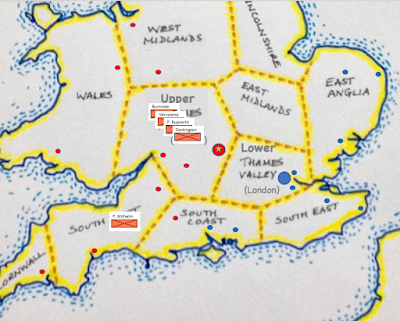1642: September/October
Reports reached London and Oxford of the recent successful move by SirArron Graces, the famous actor, poet and bard who commands one of Sir Bevill Dedge's brigades, he has now secured the South East Region for Parliament.
Sir Aaron was seen leading his men south, accompanied by his twin Border Collies Piper & Drummer, as ever Sir Arron was on foot at the forefront of his forces.
With this move the towns, cities and countryside of the South East region are in the hands of the People. In doing so he also takes control of the strongly pro Parliament towns & cities of Dover & Canterbury, see the blue dots on the map below.
 |
| Graces' force is signified by the light blue tile. |
Whilst Parliamentary leaders in London are congratulating themselves on completing this part of their master plan, the enemy in Oxford are also aware of Graces' movement - but as ever, they have no indication of his relative strength or if he or Sir Bevill have garrisoned any location in either the South East or Lower Thames Valley, as far as they are concerned at present the entire enemy force remains in the field, albeit spread across two regions.
In celebration of his occupation of the region, Sir Aaron writes and performs his latest Sonnet to the gentlefolk of the South East to much applause...
In yonder realm, where shadows
cast their pall,
A valiant knight did rise, by honour driven,
Sir Aaron Graces, leader strong and tall,
With heart ablaze, his cause was thusly given.
From Sussex to fair Surrey's verdant plains,
He led his foot brigade with steadfast might,
To break the chains of tyranny's cruel reign,
And free the land from Charles the tyrant's blight.
Brave Graces, noble knight of righteous aims,
His sword gleamed bright, his armour staunch and true,
With every step, he quelled the people's claims,
And ushered in an era that was new.
Oh, gallant leader, fierce and full of grace,
Your name shall shine through time, a beacon's trace.
Strategic initiative now passes to the Royalist Team, where Paul acting as Lord Cockington must deliberate on his and the Royalist's next move.
Campaign Materials sourced from Steven Bagalan / Map by Peter Davies



























